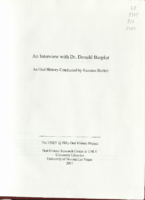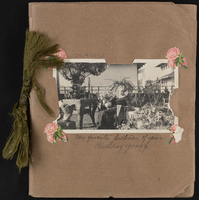Search the Special Collections and Archives Portal
Search Results

Pat Jones Photograph Collection
Identifier
Abstract
The Pat Jones Photograph Collection (approximately 1925-1930) consists of black-and-white photographic prints and slides of Harry Suiter in Rhyolite, Nevada. There are images of Suiter standing in front of abandoned buildings, as well as scenery near Rhyolite. Also included is an image of a wagon transport containing borax in Death Valley, California.
Archival Collection
First Methodist Church of Las Vegas Photograph Collection
Identifier
Abstract
The First Methodist Church Photograph Collection (approximately 1909-1912) contains black-and-white photographic prints and corresponding negatives of the Las Vegas train depot, railroad yards, and the First Methodist Church in Las Vegas, Nevada. Also included are portraits of Reverend Edwin A. Palmer and his family.
Archival Collection
Edward Joseph Deck Photograph Collection
Identifier
Abstract
The Edward Joseph Deck Photograph Collection (approximately 1870-1920) consists of photographic prints and negatives of Edward Joseph Deck and other miners in Pioche, Nevada and various locations around the townsite. There are also images of ranches, mills, and mill workers both in and outside of the Pioche townsite.
Archival Collection
Nino Maurizi Photograph Collection
Identifier
Abstract
The Nino Maurizi Photograph Collection consists of two black-and-white photographic prints and corresponding negatives of Nino Maurizi at the Mount Charleston Camp for the Las Vegas Army Air Field in 1943. Images depict Maurizi standing at the entrance of Mount Charleston Camp as well as inside the camp.
Archival Collection
Esther Ruth Peaslee Postcard Collection
Identifier
Abstract
The Esther Ruth Peaslee Postcard Collection (approximately 1900-1983) consists of postcards and postcard reproductions depicting a Labor Day celebration in Goldfield, Nevada, the Angelus Hotel, and the Goldfield Hotel. The reproductions were made approximately between 1960 and 1983. Also included is a postcard showcasing scenes in Goldfield.
Archival Collection
Stuart A. McCarthy Photograph Collection
Identifier
Abstract
The Stuart A. McCarthy Photograph Collection (approximately 1940-1949) consists of photographic prints and negatives of the Photo Mart storefront on Fremont Street as well as a view of the Golden Nugget, Eldorado Club, Hotel Apache, Boulder Club, and the Pioneer Club on Fremont Street in Las Vegas, Nevada.
Archival Collection
Theodore M. Parsons Photograph Collection
Identifier
Abstract
The Theodore M. Parsons Photograph Collection (1936-1988) consists of photographic prints and negatives depicting Theodore M. Parsons and other Civilian Conservation Corps (CCC) workers in Boulder City, Nevada between 1936 and 1942. There are individual images of Parsons as well as group photographs of workers at CCC camps and public gatherings.
Archival Collection

Transcript of interview with Dr. Donald Baepler by Suzanne Becker, April 23, 2007
Date
Archival Collection
Description
Text

Helen J. Stewart birthday scrapbook
Date
Archival Collection
Description
Helen J. Stewart birthday scrapbook
Mixed Content
